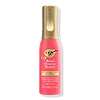What's inside
What's inside
 Key Ingredients
Key Ingredients

No key ingredients
 Benefits
Benefits

 Concerns
Concerns

 Ingredients Side-by-side
Ingredients Side-by-side

Water
Skin ConditioningCocos Nucifera Oil
MaskingAmodimethicone
PPG-5-Ceteth-10 Phosphate
EmulsifyingPolyquaternium-37
Phenoxyethanol
PreservativeParfum
MaskingPropylene Glycol Dicaprylate/Dicaprate
EmollientSodium Hydroxide
BufferingDimethicone
EmollientBehentrimonium Chloride
PreservativePPG-1 Trideceth-6
Skin ConditioningTrideceth-6
EmulsifyingEthylhexyl Salicylate
UV AbsorberEthylhexylglycerin
Skin ConditioningPropylene Glycol
HumectantIsopropyl Alcohol
SolventSorbitan Oleate
EmulsifyingDimethiconol
EmollientLimonene
PerfumingCetrimonium Chloride
AntimicrobialLinalool
PerfumingHydroxycitronellal
PerfumingCitronellol
PerfumingCoumarin
PerfumingRosa Centifolia Extract
Skin ConditioningGeraniol
PerfumingPrunus Amygdalus Dulcis Seed Extract
Skin ConditioningTocopherol
AntioxidantXanthan Gum
EmulsifyingCeramide AP
Skin ConditioningWater, Cocos Nucifera Oil, Amodimethicone, PPG-5-Ceteth-10 Phosphate, Polyquaternium-37, Phenoxyethanol, Parfum, Propylene Glycol Dicaprylate/Dicaprate, Sodium Hydroxide, Dimethicone, Behentrimonium Chloride, PPG-1 Trideceth-6, Trideceth-6, Ethylhexyl Salicylate, Ethylhexylglycerin, Propylene Glycol, Isopropyl Alcohol, Sorbitan Oleate, Dimethiconol, Limonene, Cetrimonium Chloride, Linalool, Hydroxycitronellal, Citronellol, Coumarin, Rosa Centifolia Extract, Geraniol, Prunus Amygdalus Dulcis Seed Extract, Tocopherol, Xanthan Gum, Ceramide AP
Water
Skin ConditioningPolysorbate 80
EmulsifyingParfum
MaskingPEG-40 Hydrogenated Castor Oil
EmulsifyingAmodimethicone
Isopentyldiol
HumectantTriticum Vulgare Protein
BufferingHydroxypropylgluconamide
HumectantHydroxypropylammonium Gluconate
HumectantPanthenol
Skin ConditioningGlycerin
HumectantCetrimonium Chloride
AntimicrobialTrideceth-15
EmulsifyingTrideceth-3
EmulsifyingLinoleamidopropyl Pg-Dimonium Chloride Phosphate
Citric Acid
BufferingAminomethyl Propanol
BufferingPhenoxyethanol
PreservativeEthylhexylglycerin
Skin ConditioningWater, Polysorbate 80, Parfum, PEG-40 Hydrogenated Castor Oil, Amodimethicone, Isopentyldiol, Triticum Vulgare Protein, Hydroxypropylgluconamide, Hydroxypropylammonium Gluconate, Panthenol, Glycerin, Cetrimonium Chloride, Trideceth-15, Trideceth-3, Linoleamidopropyl Pg-Dimonium Chloride Phosphate, Citric Acid, Aminomethyl Propanol, Phenoxyethanol, Ethylhexylglycerin
Ingredients Explained
These ingredients are found in both products.
Ingredients higher up in an ingredient list are typically present in a larger amount.
This water-soluble silicone is used for its hydrating and softening properties. It is used to add a silky feel to skincare products and has great benefits for haircare.
In haircare, this ingredient:
- Adds shine
- Protects color
- Offers thermal protection
- Boosts hair strength
- Does not build up as easily
This ingredient is a preservative, antimicrobial, and emulsifier. It is often used in cosmetics for its ability to cleanse, condition, and reduce static.
Cetrimonium chloride is a quaternary ammonium salt, meaning it has a water-soluble structure.
Ethylhexylglycerin (we can't pronounce this either) is commonly used as a preservative and skin softener. It is derived from glyceryl.
You might see Ethylhexylglycerin often paired with other preservatives such as phenoxyethanol. Ethylhexylglycerin has been found to increase the effectiveness of these other preservatives.
Parfum is a catch-all term for an ingredient or more that is used to give a scent to products.
Also called "fragrance", this ingredient can be a blend of hundreds of chemicals or plant oils. This means every product with "fragrance" or "parfum" in the ingredients list is a different mixture.
For instance, Habanolide is a proprietary trade name for a specific aroma chemical. When used as a fragrance ingredient in cosmetics, most aroma chemicals fall under the broad labeling category of “FRAGRANCE” or “PARFUM” according to EU and US regulations.
The term 'parfum' or 'fragrance' is not regulated in many countries. In many cases, it is up to the brand to define this term.
For instance, many brands choose to label themselves as "fragrance-free" because they are not using synthetic fragrances. However, their products may still contain ingredients such as essential oils that are considered a fragrance by INCI standards.
One example is Calendula flower extract. Calendula is an essential oil that still imparts a scent or 'fragrance'.
Depending on the blend, the ingredients in the mixture can cause allergies and sensitivities on the skin. Some ingredients that are known EU allergens include linalool and citronellol.
Parfum can also be used to mask or cover an unpleasant scent.
The bottom line is: not all fragrances/parfum/ingredients are created equally. If you are worried about fragrances, we recommend taking a closer look at an ingredient. And of course, we always recommend speaking with a professional.
Learn more about ParfumPhenoxyethanol is a preservative that has germicide, antimicrobial, and aromatic properties. Studies show that phenoxyethanol can prevent microbial growth. By itself, it has a scent that is similar to that of a rose.
It's often used in formulations along with Caprylyl Glycol to preserve the shelf life of products.
Water. It's the most common cosmetic ingredient of all. You'll usually see it at the top of ingredient lists, meaning that it makes up the largest part of the product.
So why is it so popular? Water most often acts as a solvent - this means that it helps dissolve other ingredients into the formulation.
You'll also recognize water as that liquid we all need to stay alive. If you see this, drink a glass of water. Stay hydrated!
Learn more about Water